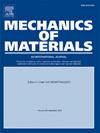A unified thermomechanically-consistent framework for fatigue failure entropy
IF 3.4
3区 材料科学
Q2 MATERIALS SCIENCE, MULTIDISCIPLINARY
引用次数: 0
Abstract
This paper aims to develop a cyclic thermo-elastoplastic constitutive model to assess entropy generated due to uniaxial fatigue loading. The study is based on a finite element discretization for repetitive loading/unloading cycles to determine the internal dissipation and associated entropy generation. The primary objective of the study is to explore the internal friction effect as a non-destructive dissipative mechanism through the application of two distinct approaches: creep-like entropy for phenomenological yield stress relaxation and an extrapolated scheme from the thermoelastic constitution. The first facilitates a seamless transition for yield stress values, allowing them to pass smoothly from macro-plasticity to microplasticity, while incorporating a unified scheme of deformation-induced internal friction effects into constitutive equations as the material's internal state evolves. A simple self-consistent homogenization scheme is applied to establish a link between the plasticity scale submitted to cyclic loading. The latter was introduced for the first time via a rate-dependent creep-plasticity entropy to account for the non-damaging part of dissipation in both macro- and micro-plastic-dominated fatigue. This establishes a link between the mechanical degradation rate and the progression of the fatigue cycle. An additive decomposition of total entropy can individualize the inelastic entropy rate as an additional thermal part, representing a phenomenological creep-like relaxation, indicative of internal friction. Furthermore, the progression of the thermo-plastic friction effects is evaluated using the dual thermo-elastoplastic tangent modulus to provide the possibility of activating natural cooling, particularly when the mechanical loads are halted. The results of the finite element simulations show that the calculated Fracture Fatigue Entropy (FFE) values fall within a narrow range, confirming its constancy and usefulness as a material property.

疲劳失效熵的统一热-力学一致框架
本文旨在建立一个循环热弹塑性本构模型来评估单轴疲劳载荷产生的熵。该研究基于重复加载/卸载循环的有限元离散化,以确定内部耗散和相关熵的产生。本研究的主要目的是通过应用两种不同的方法来探索内摩擦效应作为一种非破坏性耗散机制:现象屈服应力松弛的蠕变熵和热弹性结构的外推方案。第一个促进了屈服应力值的无缝过渡,允许它们从宏观塑性平滑地过渡到微塑性,同时随着材料内部状态的演变,将变形引起的内摩擦效应的统一方案纳入本构方程。采用一种简单的自洽均质方案建立循环加载塑性尺度之间的联系。后者首次通过速率相关的蠕变塑性熵引入,以解释宏观和微塑性主导疲劳中耗散的非损伤部分。这建立了机械退化率与疲劳循环进程之间的联系。总熵的加性分解可以将非弹性熵率个别化为附加的热部分,代表一种现象蠕变松弛,表明内摩擦。此外,使用双热弹塑性切线模量来评估热塑性摩擦效应的进展,以提供激活自然冷却的可能性,特别是当机械负载停止时。有限元模拟结果表明,计算得到的断裂疲劳熵(FFE)值在一个较窄的范围内,证实了其作为材料性能的稳定性和实用性。
本文章由计算机程序翻译,如有差异,请以英文原文为准。
求助全文
约1分钟内获得全文
求助全文
来源期刊

Mechanics of Materials
工程技术-材料科学:综合
CiteScore
7.60
自引率
5.10%
发文量
243
审稿时长
46 days
期刊介绍:
Mechanics of Materials is a forum for original scientific research on the flow, fracture, and general constitutive behavior of geophysical, geotechnical and technological materials, with balanced coverage of advanced technological and natural materials, with balanced coverage of theoretical, experimental, and field investigations. Of special concern are macroscopic predictions based on microscopic models, identification of microscopic structures from limited overall macroscopic data, experimental and field results that lead to fundamental understanding of the behavior of materials, and coordinated experimental and analytical investigations that culminate in theories with predictive quality.
 求助内容:
求助内容: 应助结果提醒方式:
应助结果提醒方式:


